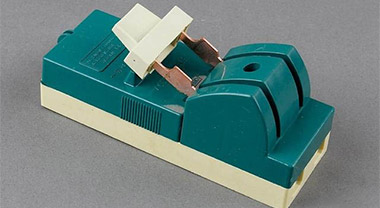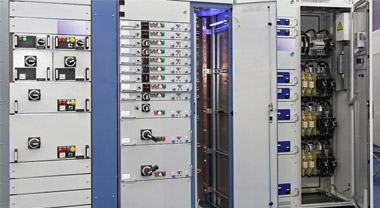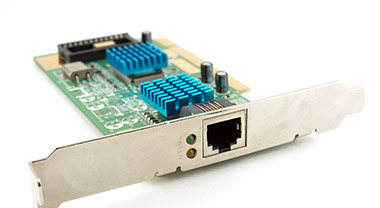6 principles for circuit breaker selection
Circuit breakers can be divided into distribution type circuit breakers, motor protection type circuit breakers, household protection type circuit breakers, leakage circuit breakers, etc. according to their use. According to their different protection characteristics, this article introduces how to choose a suitable circuit breaker in order to choose The circuit breaker is used as a basis.
1. Current and voltage selection requirements:
- Circuit breaker rated voltage ≥ line rated voltage;
- The rated current of the circuit breaker ≥ the calculated load current of the line;
- the rated current of the circuit breaker release ≥ the calculated load current of the line;
- The limit breaking capacity of the circuit breaker ≥ the maximum short-circuit current in the line;
- The automatic switch instantaneous (or short delay) trip setting current with a single-phase-to-ground short-circuit current at the end of the line not less than 1.25 times;
- The rated voltage of the undervoltage release of the circuit breaker is equal to the rated voltage of the line.
2. Selection of circuit breakers for power distribution.
Circuit breakers for distribution are generally used in low-voltage power grids specifically for the distribution of electrical energy, including power supply circuit breakers and load branch circuit breakers. When selecting this type of circuit breaker, pay special attention to the following selection principles:
- The allowable current carrying capacity of the line is not less than the setting value of the long-delay operating current of the circuit breaker. If wire and cable are used, the long-delay operating current setting value of the circuit breaker can be 80% of the allowable current carrying capacity of the wire and cable.
- The starting time of the motor with the largest starting current in the circuit is not more than 3 times the return time of the set value of the long delay action current. 3) Instantaneous current setting value I1: I1=1.1 (Ijx+klkIedm). Among them: kl is the impact coefficient of the motor starting current, generally kl=1.7~2; Iedm is the maximum rated current of a motor.
3. Selection of motor protection circuit breaker.
Motors have two characteristics: one is that the starting current is usually several times the rated current; the other is that it has a certain overload capacity. Therefore, when choosing a circuit breaker to protect the motor, we must pay attention to these two characteristics of the motor. In order to ensure the reliable operation of the motor, the following points should be paid attention to when selecting the circuit breaker:
- Determine the long-delay operating current setting value of the circuit breaker with the rated current of the motor.
- The returnable time of the 6 times long delay action current setting value of the circuit breaker> the actual starting time of the motor. 3) The instantaneous operating current setting value of the circuit breaker: the cage motor should be 8-15 times the rated current of the trip unit; the winding motor should be 3-6 times the rated current of the trip unit.
4. Selection of household protective circuit breakers.
In household power supply, circuit breakers are usually used as main power protection switches or branch line protection switches. If there is a short circuit or overload in the circuit or household appliances, the circuit breaker can automatically trip and cut off the power supply, thereby effectively protecting these equipment from damage and reducing the accident to the smallest range.
In the family, a single pole (1P) is generally used for branch protection; a two-pole (ie 2P) circuit breaker is used for main power protection. It is important to choose the rated capacity and current of the circuit breaker in the family, because if the rated current of the circuit breaker is selected too large, the circuit or household appliances will short-circuit or overload, the circuit breaker cannot automatically trip and cut off the power supply. If the selected value is too small, The circuit breaker is easy to trip frequently, causing unnecessary power outages, affecting normal life, and causing unnecessary trouble.
Generally, the general miniature circuit breaker specifications are distinguished by the rated current, mainly 6A, 10A, 16A, 20A, 25A, 32A, 40A, 50A, 63A, 80A, 100A, etc.; general households should pay attention when selecting or checking the total value of the total load current The following points:
- The value of each branch current
Formula I=power/200v;
For example, a 200w bulb, branch current I=200W/220=0.9A
Resistive load appliances include light bulbs, electric heaters, electric fans, electric frying pans, electric heaters, electric irons, electric blankets, electric rice cookers, vacuum cleaners, electric water heaters, air conditioners, etc.
b. The calculation of inductive load is a little more complicated, the power consumption should be considered, and the specific calculation should also consider the power factor. To facilitate the estimation, I give a simple calculation method. For general inductive loads, indicate the power calculated based on the load. For example, indicate that the branch current of a 200W fluorescent lamp is I=200W/220v=0.9A, which is doubled to 0.9*2=1.8A (1.5A more than the exact calculated value, 0.3A more).
Perceptual appliances include televisions, washing machines, fluorescent lamps, refrigerators, and fluorescent lamps.
- The total load current is the sum of each branch current
Knowing the branch current and total current, you can select the specifications of the branch circuit breaker and the main circuit breaker, or check whether the specifications of the designed electrical components meet the safety requirements; in order to ensure safety and reliability, the rated operating current of the electrical components should generally be More than 2 times the required maximum load current; In addition, when selecting electrical components, the possibility of future increase in electrical load should also be considered, so as to leave a margin for future demand.
5. Selection of leakage circuit breaker
Leakage circuit breakers are generally divided into two poles, three poles, and four poles, which are used in different circuits. Only the correct selection and use can play its due role, so pay attention to the following five points when choosing a leakage circuit breaker:
- The rated current of the overload release ≥ the maximum load current of the circuit;
- The ultimate breaking capacity of the circuit breaker ≥ the circuit * maximum short-circuit current;
- The leakage current to be protected by the circuit should be ≤ the specified leakage protection current of the circuit breaker
- The normal working voltage and current of the line equipment ≤ the rated voltage and current of the circuit breaker;
- It has a short breaking response time, which can protect the line and equipment.
Sometimes it is difficult to judge whether to choose a four-pole circuit breaker in the application. Here are the principles to be followed for whether to choose a four-pole circuit breaker. A four-pole circuit breaker should be selected in the following situations:
- According to the provisions of IEC465.1.5, the conversion circuit breaker between the normal power supply and the standby generator;
- The dual power conversion circuit breaker with leakage protection should adopt a four-pole circuit breaker. The two upper-level circuit breakers have leakage protection, and the lower-level power conversion circuit breaker;
- The power supply switch circuit breaker between two different grounding systems;
- The power inlet circuit breaker of the TT system;
- When there is a middle in the IT system The circuit breaker used when the neutral wire is drawn.
In the following cases, it is generally not necessary to use a four-pole circuit breaker or the use of a four-pole circuit breaker is prohibited:
- TN-S and TN-C-S systems generally do not need to be equipped with four-pole circuit breakers;
- Four-pole circuit breakers are strictly prohibited in TN-C systems.
6. Precautions during use after the circuit breaker is selected
After the circuit breaker is selected, pay attention to the following during use: The leakage, overload, and short-circuit protection characteristics of the circuit breaker are set by the manufacturer, and cannot be adjusted at will during use to avoid affecting performance; after the circuit is connected, it should be Check whether the wiring is correct. It can be checked by the test button. After the circuit breaker is disconnected due to a short circuit, the contacts need to be checked. If the main contact is severely burned or has pits, it needs to be repaired; if the circuit breaker cannot be broken, it means that the circuit breaker or circuit is faulty and needs to be repaired; After the leakage protector is put into operation, after a period of time, the user should check whether the circuit breaker is operating normally through the test button; the load wiring of the leakage circuit breaker must pass through the load end of the circuit breaker, and no phase or neutral line of the load is allowed to fail. After the leakage circuit breaker, artificial "leakage" will occur, which will cause the circuit breaker to fail to close and cause "misoperation". The four-pole leakage circuit breaker must be connected to the neutral line to make the electronic circuit work normally; the function of the inspection button is to check the operating status of the circuit breaker after it is newly installed or operated for a certain period of time when it is closed and energized. Press the test button, the circuit breaker can be broken, indicating that it is operating normally and can be used continuously; in order to protect the circuit and equipment more effectively, the leakage circuit breaker can be used in conjunction with the fuse. When the circuit breaker is broken due to a fault in the protected circuit, the operating handle is in the trip position. After finding out the cause and removing the fault, the operating handle should be pulled down first to make the operating mechanism "re-buckle" before the closing operation can be performed.




